Minds On
Task 1: Factories
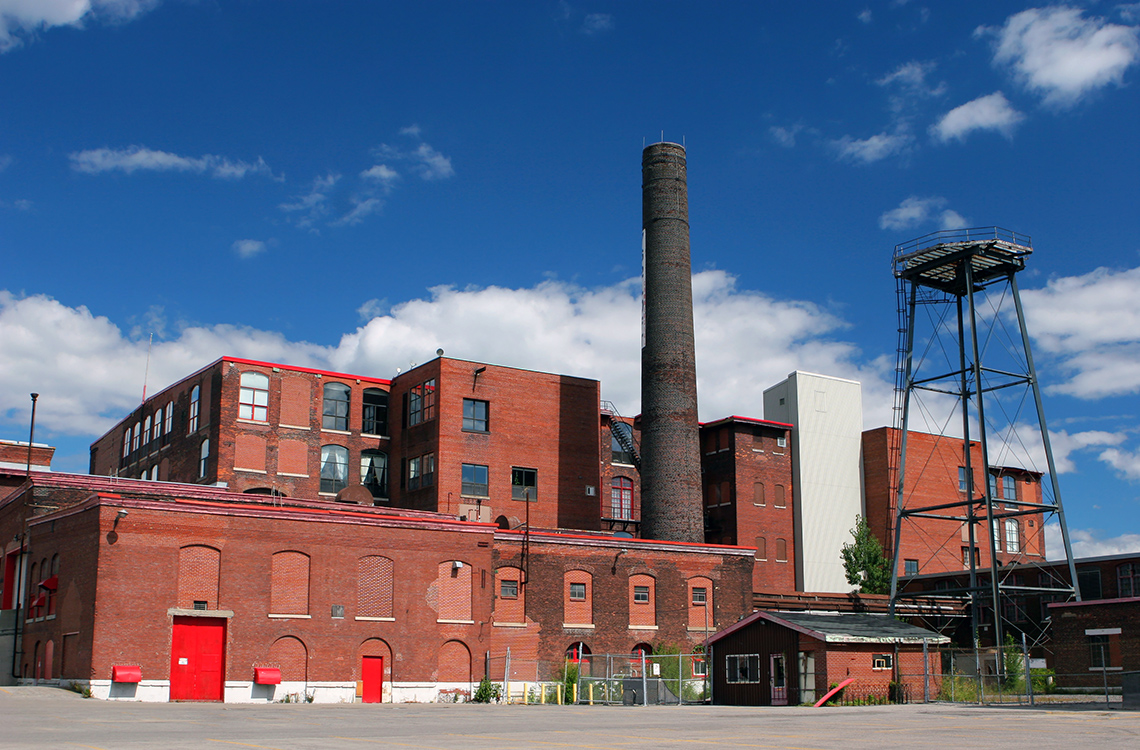
Think about modern factories that you know exist today. Brainstorm a list of advantages and disadvantages of a factory using a method of your choice.
Task 2: Advancements

vintage vs modern technologies
This is an image of a desk from the top-view. The desk is divided between the left and right side. The left side shows “vintage” technologies, such as a rotary phone, a large camera, a notebook, pen, envelope, and half a typewriter. On the right side there is a more modern camera, cellphone, glasses, iPad, stylist pen, cup of coffee, and half of a laptop computer that lines up with half of the typewriter.
What are some of the technological advancements you can think of that have developed over time? How have they improved our life? Do you think we are dependent on technology?
Record your ideas using a method of your choice.
Action
Task 1: Industrialization
Review the following definitions.
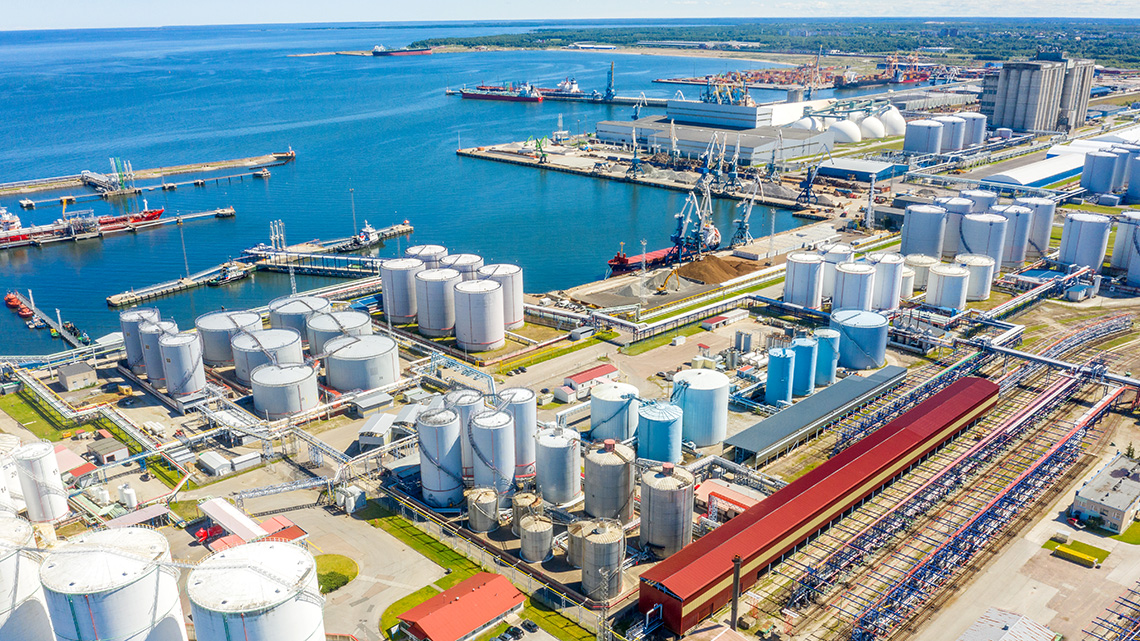
The Second Industrial Revolution took place in Canada between 1860 and 1950 and was marked by assembly lines and large-scale factories. During this period, rail, steel, consumer goods, automotive sectors, and technological advancements transformed the Canadian economy.
The Second Industrial Revolution created a shift from industries based in agriculture and production of raw natural resources to manufacturing and service industries which meant:
- new technologies were developed
- use of factories promoted work for children and women
- there was less of a reliance on lumber and the fur trade
- cities expanded as people moved closer to the cities for work
- economic power was concentrated in Montreal and Toronto
Brainstorm
Make a prediction
What do you think are some of the pros and cons of the Industrial Revolution in Canada?
Press the ‘Hint’ button if you need some help getting started.
Components of industrialization
In this section you will be exploring various components of industrialization and assessing the pros (advantages) and cons (disadvantages) of each.
As you read about the following components of industrialization, use the fillable and printable Pros and Cons Graphic Organizer document to record your findings. You can also complete this activity using another method of your choice.

Press the Activity button to access the Pros and Cons Graphic Organizer.
Activity(Open PDF in a new window)Farming/agriculture
Before the Industrial Revolution, farming and agriculture were more than just a job, but rather a way of life for many, as there was a high and constant demand for food. The Second Industrial Revolution brought a wave of inventions and advancements that allowed the development of mass production and large-scale farming, which resulted in a surplus of food that could be distributed through railways and canals.
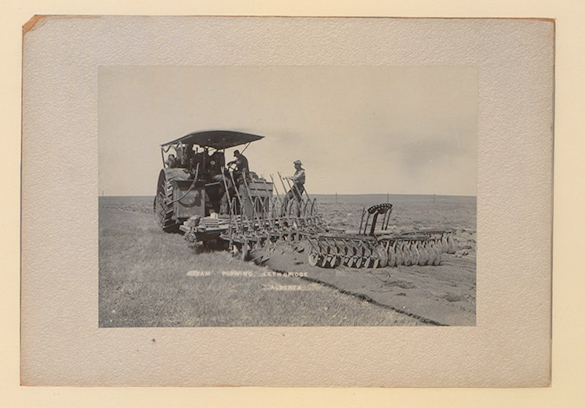
Steam Powered Tractor
This photograph is of a steam powered tractor that transformed productivity during this time. One man is riding on the tractor and another man is standing on the back. There are large claw like pieces that are on the back of the tractor which is being dragged over the farm land.
A few key advancements in agriculture were:
- the seed drill
- crop rotation
- food preservation using salts and sugars
- large-scale animal farms (new laws allowed animals to be fenced in)
- cotton gin
In agriculture, these advancements meant changes were being made in the organization and management of farms. For example, wealthy landowners were buying out smaller family run farms to make land more productive, which meant a lot of people were forced to move to the city to find new work. Advancements meant farmers required more expensive equipment, adequate farm buildings, access to roads and drainage, and transportation in order to "keep up" in the industry (Dunn, 2011).
Urbanization
Urbanization is a process in which there is an increase in the percentage of people living in and/or working in urban places (cities). Between 1870 and 1920, the development of Canada was linked by rail, telegraph, canal, post office, and telephone systems. Economic power was centralized in Montreal and Toronto and urban development expanded. Rapid expansion of suburbs, along with streetcars and the promise of non-agricultural work, drew people to the city.
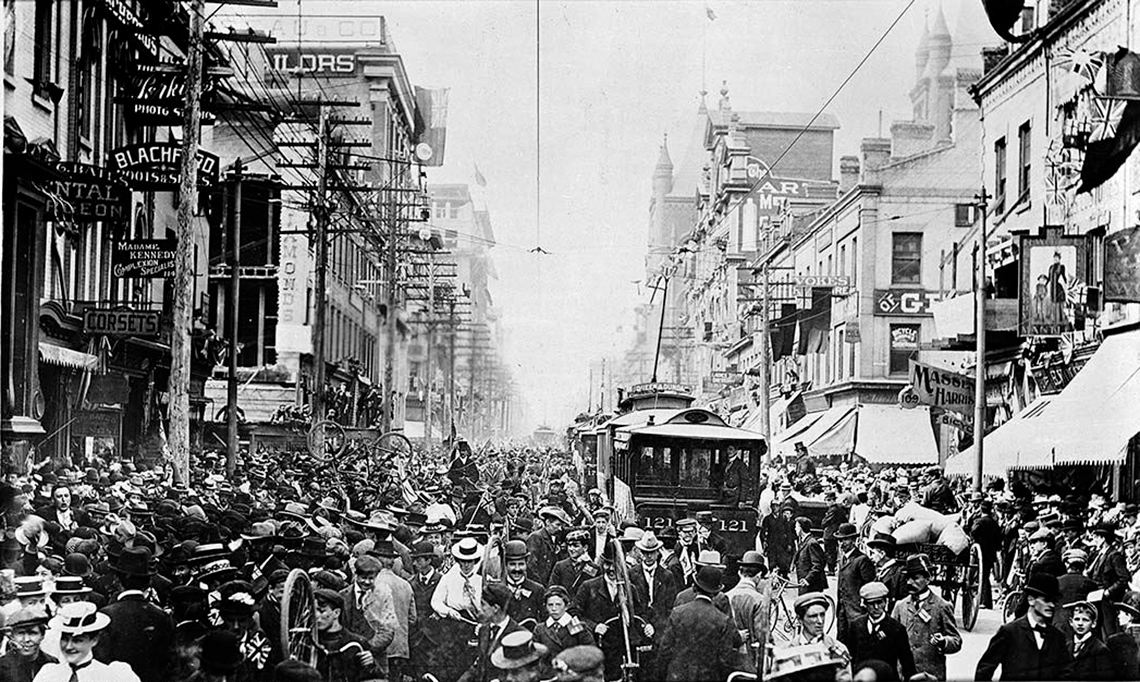
Street in Toronto in 1901
This is a photograph of a street in Toronto in 1901. There are buildings along both the left and right side of the photograph with a street in the center. The street is packed with people, shoulder to shoulder trying to get around. There is a streetcar in the middle and a horse-drawn carriage on the right side.
The promise of better wages attracted people to the cities. However, industrial towns were not prepared to handle the influx of people. Initially, there were housing shortages, and local sanitation and sewage were not adequate. People were drinking unsafe water, living in close proximity, and working in poor conditions which led to an outbreak of disease. This spurred medical advancements and the development of modern building codes, health laws, and urban planning. With factories developing in the cities, owners wanted profit over anything, which meant poor working conditions and lack of safety. Factory workers laboured up to 16 hours a day, six days a week. Factories were dirty and unsafe, which led to workplace injuries and death (Belshaw, 2016).
Social classes
Prior to the Industrial Revolution, there were really only two classes – the rich landowners and poor land workers. Mass production lowered the costs of goods, which allowed people to save money for others things and build personal wealth. New factories allowed for new employment opportunities, which reduced the need for land ownership.

Working class men
There are many men in this photo which represents the working class. Several of them are wearing aprons, and are working in a factory with large machines.
This led to a subsequent growth in the middle class and specialized industries, such as builders, teachers, lawyers, physicians, etc., where they needed to meet the various needs of residents in the city. There were three classes that emerged from the Industrial Revolution:
- The Working Class were factory workers (or “low skilled jobs”) and they were considered the poorest and at the bottom of the class structure.
- The Middle Class were typically managers, business owners, and those with skilled jobs.
- The Upper Class were a small portion of the population who owned the larger corporations.
Women and children
The Second Industrial Revolution impacted social classes in a variety of ways, including working class women who began working to provide for their families. Women were employed in factories and “outwork.” Outwork was when materials were taken home by workers and stitched together or in some way refined to add value. However, gender was a major influence on worker salary.
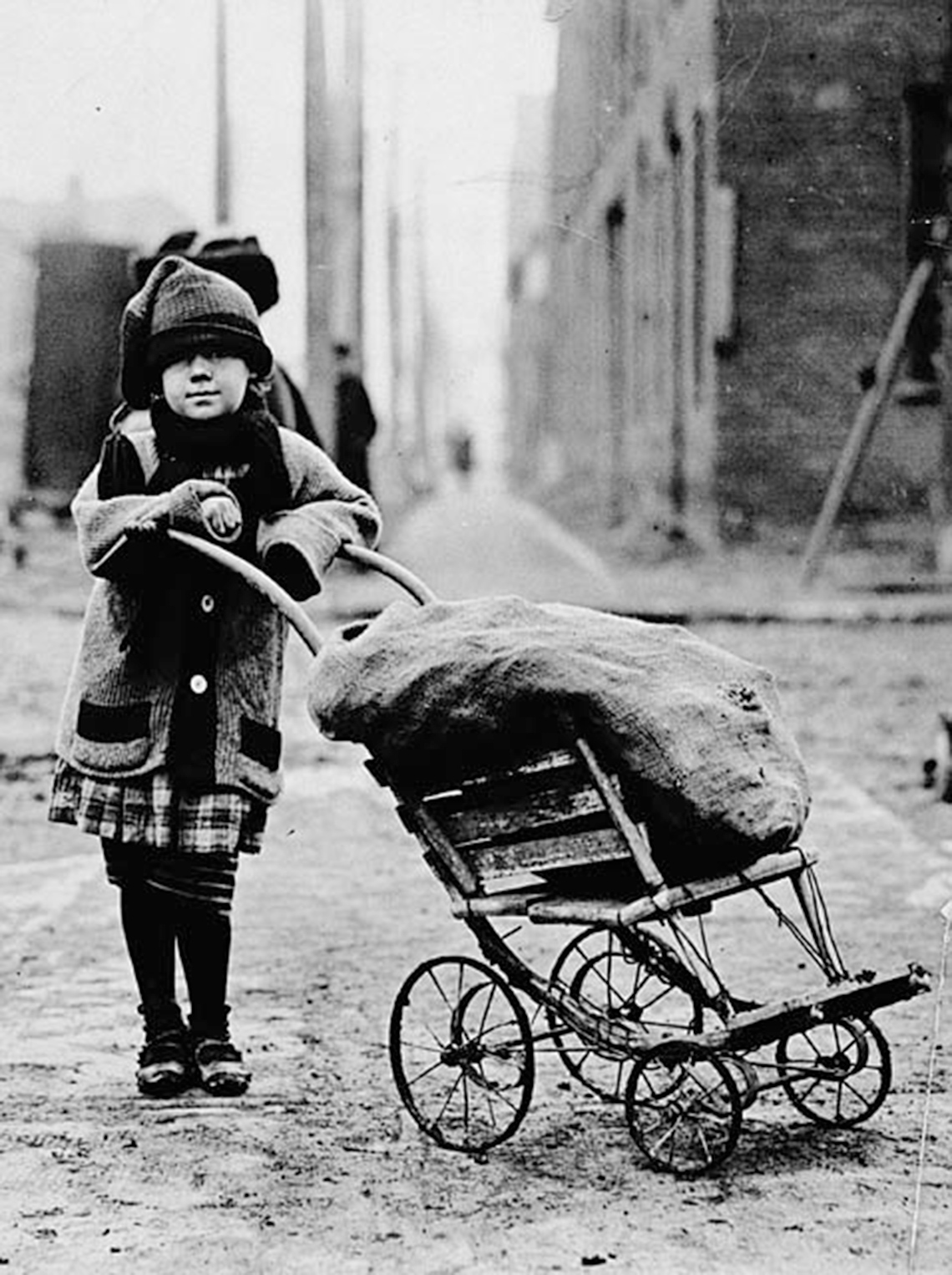
Young child pushing a bag of coal
This image is from 1901. There is a young child posing for the camera. They are pushing a basket with four wheels that is carrying a bag of coal. The background of this image has a large building, posts, and someone standing and walking.
Women generally received one third or one half of the wage of a man. Children were a key component to providing labour among the working class during this time. Boys and girls had different experiences in wage labour. Girls often worked with textiles and “stitchery” whereas boys were part of an apprenticeship, where their skill and wage were intended to increase over time. Many industries exploited their need for women and children because it was cheaper to employ them (Belshaw, 2016).
By now, you will have filled out your Pros and Cons Graphic Organizer document. To review your answers, examine the following printable Pros and Cons Graphic Organizer document to explore some possible answers to this activity.
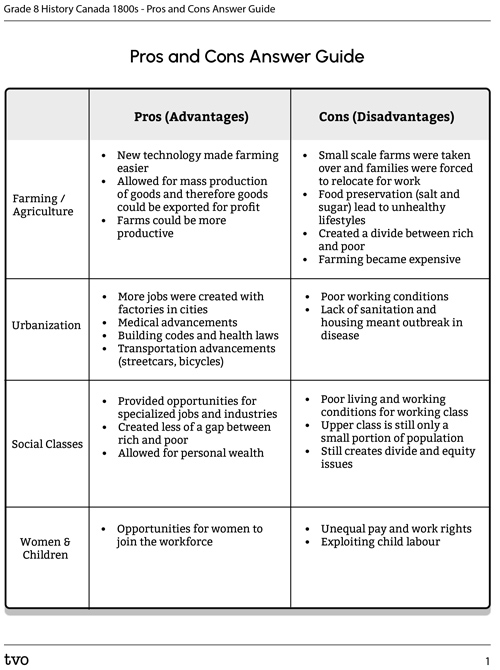
Press the Activity button to access the Pros and Cons Graphic Organizer.
Activity(Open PDF in a new window)Task 2: Inuit life
The term Inuit refers broadly to the Arctic Indigenous population of Alaska, Canada, and Greenland. Inuit means “people,” and the language they speak is called Inuktitut. Today, the Inuit communities of Canada live in the Inuit Nunangat in four different regions. For centuries, the Inuit survived on primarily fish and sea mammals, such as whales, caribou, and walruses. The Inuit chose to live in small, family-based groups rather than large, permanent settlements. They built different homes to accommodate the winter and summer climate of the Arctic.
In the winter, the Inuit built and lived in igloos made from frozen snow. In the summer, they built homes out of animal bones and hide. These homes were easy to rebuild in different locations as they moved for hunting and gathering. The Inuit believed all things had a spirit. A spirit could be found in both living and non-living things, such as people, animals, inanimate objects, and forces of nature. They believed when a spirit died, it would continue living in another spirit.
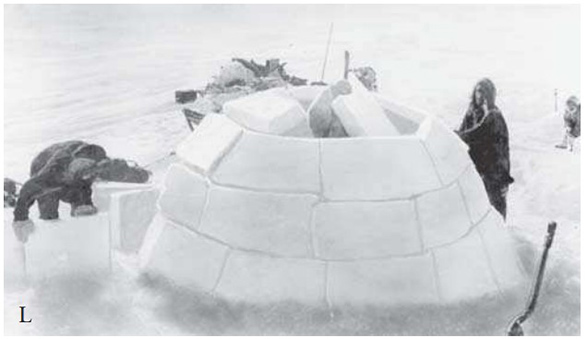
Igloo building
This is a photo of two men building an igloo. The man on the left side is bending over to lift an ice block. The man on the right side is setting and curving the ice block. Behind the igloo there is a cart with materials for building. The background has a lot of snow.

Inuit Summer Dwelling
This is a photo of Inuit summer dwelling. It is a small tipi with rocks along the right side. There are two bars behind the tipi. The bar on the left hand side has material cut up into strips hanging down from it. The bars on the right side has a stick that is in the ground with a triangular dome on the top.
In the 1900s, European colonizers began to take routine trips to set up summer trading posts in the Arctic regions. As the fur trade came to an end, many Inuit communities were left with no means to thrive as it was depleted by colonizers. Inuit communities across the Arctic suffered greatly from malnutrition and starvation as marine mammals depleted under pressure from European whalers, who also introduced many diseases into their communities. Industrial development threatened Inuit culture and society. To safeguard their cultural traditions against intrusive outside forces, Labrador’s Inuit community formed the Labrador Inuit Association and later filed a land claim with the government. This is only one example of how the Inuit have persevered to preserve their culture and traditions against external threats (Eshet, 2015).
Brainstorm
Brainstorm
How did industrialization change life for Inuit communities and how did they persevere to preserve their culture and way of living?
Press the ‘Answer’ button to check your response.
Task 3: Daily life of a child
In the final section of this learning activity, you will be conducting research about daily life of a child in an urban working-class family in Canada. Your task is to gain an understanding of their daily life between 1890 and 1914. You may record your findings in a method of your choice.
As you complete this activity, use the following checklist to evaluate your research.
Checklist to Guide Research
Consolidation
Task 1: Compare and contrast
Using the information that you researched in Task 3 of this learning activity, compare and contrast the daily life of a child in an urban working-class family from 1890-1914 to your own life. What similarities and differences do you notice?
Use the following fillable and printable Life in 1890-1914 vs. Modern Day Venn Diagram document. You may also complete this activity using another method of your choice.
Press the ‘Activity’ button to access Life in 1890-1914 vs. Modern Day Venn Diagram.
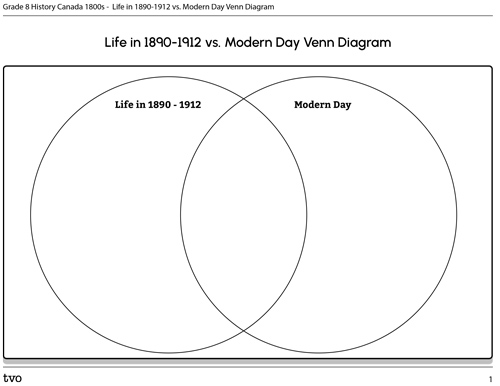
Press the Activity button to access the Life in 1890-1914 vs. Modern Day Venn Diagram.
Activity(Opens in a new tab)Task 2: Opinion paragraph

Industrialization was a starting point for many technologies and factories that still exist today. There were many advantages and disadvantages of industrialization in Canada.
Based on what you’ve learned, write an opinion paragraph in a method of your choice about industrialization and whether you believe it was an advantage or disadvantage of Canadian heritage.
As you complete this activity, use the following checklist to guide your paragraph.
Checklist to Guide Research
Reflection
As you read the following descriptions, select the one that best describes your current understanding of the learning in this activity. Press the corresponding button once you have made your choice.
I feel...
Now, expand on your ideas by recording your thoughts using a voice recorder, speech-to-text, or writing tool.
When you review your notes on this learning activity later, reflect on whether you would select a different description based on your further review of the material in this learning activity.
Press ‘Discover More’ to extend your skills.
Discover MoreInvestigate specific technological advancements that were developed between 1890 and 1914 and how they impacted Canadian society.
Is this a technological advancement we still use today? Has it changed since then or been replaced by a new technology?
